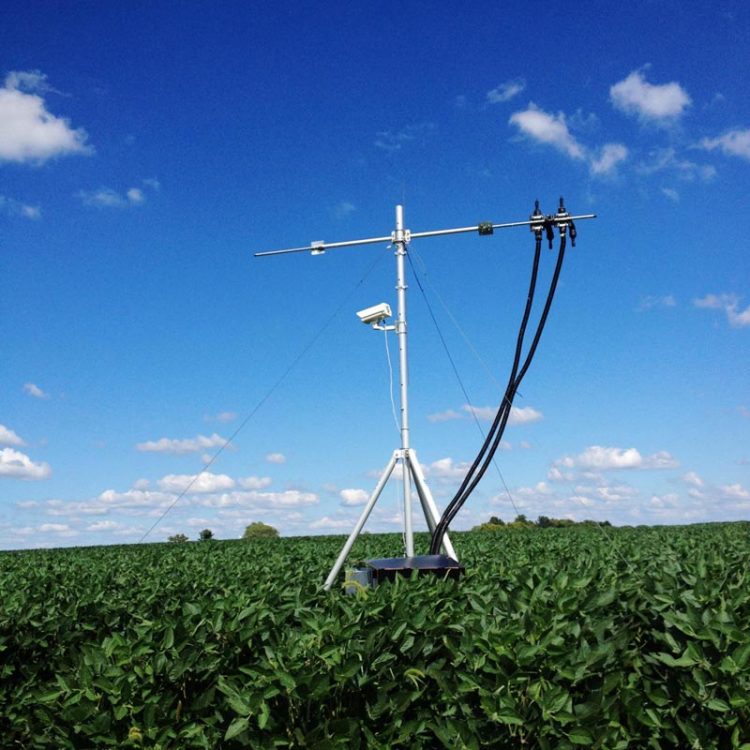Scientists monitor crop photosynthesis, performance using invisible light

Scientists evaluate the photosynthetic performance of soybeans using these towers, which use hyperspectral cameras to capture light invisible to the human eye that may one day help us predict yield on a grand scale. Credit: Guofang Miao
“Photosynthetic performance is a key trait to monitor as it directly translates to yield potential,” said Kaiyu Guan, an assistant professor in the College of Agriculture, Consumer, and Environmental Sciences (ACES) and the principal investigator of this research. “This method enables us to rapidly and nondestructively monitor how well plants perform in various conditions like never before.”
Published in the Journal of Geophysical Research – Biogeosciences, the Illinois team led by Guofang Miao, a postdoctoral researcher in ACES and the lead author of the paper, report the first continuous field season to use sun-induced fluorescence (SIF) data to determine how soybeans respond to fluctuating light levels and environmental stresses.
“Since the recent discovery of using satellite SIF signals to measure photosynthesis, scientists have been exploring the potential to apply SIF technology to better agricultural ecosystems,” said study collaborator Carl Bernacchi, an associate professor of plant science at the Carl R. Woese Institute for Genomic Biology (IGB). “This research advances our understanding of crop physiology and SIF at a local scale, which will pave the way for satellite observations to monitor plant health and yields over vast areas of cropland.”
Photosynthesis is the process where plants convert light energy into sugars and other carbohydrates that eventually become our food or biofuel. However, one to two percent of the plant's absorbed light energy is emitted as fluorescent light that is proportional to the rate of photosynthesis.
Researchers capture this process using hyperspectral sensors to detect fluctuations in photosynthesis over the growing season. They designed this continuous study to better understand the relationship between absorbed light, emitted fluorescent light, and the rate of photosynthesis. “We want to find out whether this proportional relationship is consistent across various ecosystems, especially between crops and wild ecosystems such as forests and savannas,” said Miao.
“We are also testing the applicability of this technology for crop phenotyping to link key traits with their underlying genes,” said co-author Katherine Meacham, a postdoctoral researcher at the IGB.
“SIF technology can help us transform phenotyping from a manual endeavor requiring large teams of researchers and expensive equipment to an efficient, automated process,” said co-author Caitlin Moore, also a postdoctoral researcher at the IGB.
A network of SIF sensors has been deployed across the U.S. to evaluate croplands and other natural ecosystems. Guan's lab has launched two other long-term SIF systems in Nebraska to compare rainfed and irrigated fields in corn-soybean rotations. “By applying this technology to different regions, we can ensure the efficacy of this tool in countless growing conditions for a myriad of plants,” said Xi Yang, an assistant professor at the University of Virginia, who designed this study's SIF monitoring system.
“Our ability to link SIF data at the leaf, canopy and regional scales will facilitate the improvement of models that forecast crop yields,” Guan said. “Our ultimate goal is to monitor the photosynthetic efficiency of any field across the world to evaluate crop conditions and forecast crop yields on a global scale in real time.”
###
This work was supported by the NASA New Investigator Award, the Institute for Sustainability, Energy, and Environment (iSEE), a NASA Interdisciplinary Science Award and the TERRA-MEPP (Mobile Energy-Crop Phenotyping Platform) research project that is funded by the Advanced Research Projects Agency-Energy (ARPA-E).
The paper “Sun-Induced Chlorophyll Fluorescence, Photosynthesis, and Light Use Efficiency of a Soybean Field from Seasonally Continuous Measurements” is available online (DOI: 10.1002/2017JG004180) or by request. Co-authors also include Joseph A. Berry, Evan H. DeLucia, Jin Wu, Yaping Cai, Bin Peng, Hyungsuk Kimm, and Michael D. Masters.
TERRA-MEPP (Mobile Energy-Crop Phenotyping Platform) is a research project that is developing a low-cost phenotyping robot to identify top-performing crops. TERRA-MEPP is led by the University of Illinois in partnership with Cornell University and Signetron Inc. and is supported by the Advanced Research Projects Agency-Energy (ARPA-E).
Media Contact
More Information:
http://dx.doi.org/10.1002/2017JG004180All latest news from the category: Agricultural and Forestry Science
Newest articles

“Nanostitches” enable lighter and tougher composite materials
In research that may lead to next-generation airplanes and spacecraft, MIT engineers used carbon nanotubes to prevent cracking in multilayered composites. To save on fuel and reduce aircraft emissions, engineers…

Trash to treasure
Researchers turn metal waste into catalyst for hydrogen. Scientists have found a way to transform metal waste into a highly efficient catalyst to make hydrogen from water, a discovery that…

Real-time detection of infectious disease viruses
… by searching for molecular fingerprinting. A research team consisting of Professor Kyoung-Duck Park and Taeyoung Moon and Huitae Joo, PhD candidates, from the Department of Physics at Pohang University…





















